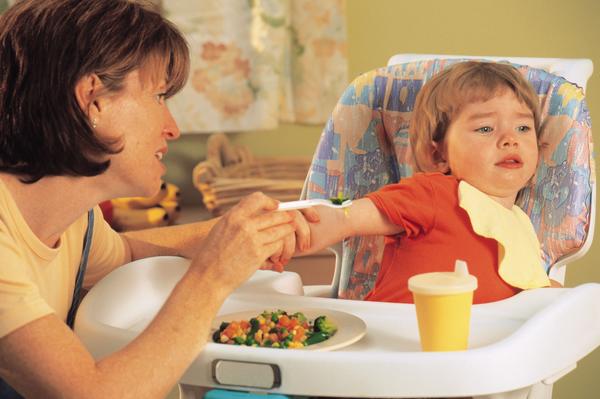How to Win the Food Battle with Your Child
October 11, 2016
If you’re a parent of a young child, you’ve been through it at least once. You know—your child won’t eat or will only eat orange things; your child will drink only juice and it has to be from the bottle with his favorite cartoon character on it; or your child only wants snacks—those delightful situations that surround mealtime. What should be a pleasant experience turns into arguments, ultimatums, bargaining and more. You’ve reached your wit’s end, and having your child sit quietly (albeit eating French fries and juice for dinner) is almost worth selling your soul to you know who.
But it doesn’t have to be like that. Sometimes when you are too deep in it, you can’t imagine a light at the end of the tunnel. However, by taking a step back (and a deep breath) along with a fresh approach, much progress can be made. It is important to remember that you should never argue, bribe or threaten your child with regard to food. While it is frustrating, to be sure, and worrisome to think that your child isn’t eating “properly,” bear in mind you are the parent or caregiver, and ultimately you decide what food and drink is kept in the house and offered to your child. Choices help (“do you want carrots or corn with your chicken?”) and maintaining a matter-of-fact tone in all discussions goes a long way toward fostering balanced conversations about food choices. Of course, if there is a serious concern or issue please speak with your child’s pediatrician. This post will cover 6 main food battle issues and suggestions, and hopefully it will help turn mealtime into fun time.
1. Basic Food Truths
One of the most basic truths about your preschooler is that he is a child—not an adult in kid’s clothing. Children have different physical and emotional needs than adults. These differences apply to the type and amount of food they eat, as well as to their behavior at eating time. Here are some things to keep in mind:
Children need smaller portions than adults. Approximately 1 tablespoon of each type of food for every year of the child’s age is an ample portion size in most cases. For example, a 2 year-old can be offered 2 tablespoons of chicken, 2 tablespoons of rice and 2 tablespoons of a vegetable.
Young children may be suspicious of new foods and recipes. Give them time to try out a new food. Try several times over the course of several months before declaring the dish a disaster.
The form a food takes can often determine whether or not it gets eaten. It isn’t uncommon for raw, crunchy vegetables to be preferred over soft, hot ones. Also, foods that can be eaten with the fingers are usually preferable to those needing utensils. Remember to cut hard-to-chew foods into very small pieces for younger children to avoid choking incidents.
Choices help. Offering your child choices—of snacks, side dishes, or type of sandwich, as examples—is important as they exercise their growing independence. It’s usually easier for a child to choose between two or three options than to make an open-ended decision. And it’s a win-win situation as you get to offer a choice of healthy options, and your child gets to select what he wants.
2. How Can I Get My Child to Give Up the Bottle?
Try to offer liquids in a cup at about 6 months old. Offer about ¼ of an ounce of liquid in small, open plastic cup. Hold the cup while your baby learns how to adjust his lips to the edge. If your child is having difficulty drinking from a cup, try the suggestions below:
Use thicker liquids. Your child’s little mouth needs practice to drink from a cup. Try using thick liquids or purees at first. A jar of strained pears makes a great shake; it’s a familiar taste and the puree is easier than milk or juice for your child’s mouth to control. The puree moves more slowly, and is heavier, making it easier to control.
Choose the right cup. Be sure the mouth of the cup is not too big. There are a variety of lidded cups available. For most children, a spouted cup is fine. If your child needs to learn more oral skills, consider using a lidded cup with no spout. This provides your child’s mouth with the same feeling as drinking from the cup lip, and prevents spills.
3. Why Should I Teach My Child to Feed Himself?
The main way to prevent feeding struggles is to teach your child how to feed himself at as early an age as possible. You can wait for your infant to show you when he is ready to eat (by leaning forward, for example) and allow him to pace the feeding himself (by such indications as turning his head). Do not insist that he empty the bottle, finish a jar of baby food, or clean the plate. By the time your child is 6-8 months of age, start giving finger foods. Such foods allow him to feed himself at least some of the time. By 12 months, your child will begin to use a spoon, and by 15 months he should be able to feed himself completely. This is your child’s first step towards independence.
4. Feeding Without Fuss
How many snacks? What about dessert? How much milk is too much? There’s much to be covered here, but we’ve simplified it into 11 helpful tips:
Prepare three meals a day with snacks in between. Your child’s stomach is small and his energy needs are high. He needs to eat every 2-3 hours.
Put your child in charge of how much he eats. Trust your child’s appetite center. The most common reason many children never seem hungry is that they have so many snacks that they never become truly hungry. Drinking too much milk can reduce a child’s appetite as well.
Provide comfort. Use a high chair or booster seat to get your toddler right up to the table. Give him a spoon and fork, but don’t make him use them. Sit down to eat with your toddler.
Help your child eat successfully. Choose foods that are easy to chew. Cut food into bite size pieces. Be careful about choking hazards, like round slices of hot dog. Let him use his hands—he needs to touch and feel the food in order to learn to like it.
Make one meal for everyone. Put a variety of nutritious foods on the table: a main dish, milk, fruit or vegetable, bread and another starchy food like rice, noodles or potatoes. Include at least one food your child usually likes.
Don’t force food. If you try to control how much your child eats, it’s hard for him to eat the right amount to grow well. If he eats only a little bit at one meal, he’ll make up for it at snack time or the next meal.
Be a good role model. Seeing you eat vegetables helps your toddler learn to like them too.
Dessert shouldn’t be a reward. If you make your toddler clean his plate to earn dessert, you teach him that dessert is better than dinner. Explain that a healthy diet includes a balance of food and dessert.
Learn some nutrition basics. Learn what foods give your child the nutrition he needs. For instance, eggs and cheese can substitute for meat, and fruits substitute for vegetables.
Plan the snacks. Think of snacks as little meals, not just sweets or treats. Offer a variety of nutritious snacks.
Be careful with juice and milk. Offer juice and milk only with meals and snacks. Keep in mind that milk contains as many calories as most solid foods. If you allow them out all day, your child may fill up and won’t eat well at mealtime. Daily milk requirements can be discussed with your child’s pediatrician, and is based on your child’s age, weight and height. If your child is thirsty, give water instead.
5. What to Do About Picky Eaters
We’ve all seen at least one of these: the child who says ‘no’ to every food offered, the child who eats only grilled cheese sandwiches, and more. Here are some suggestions for dealing with some food personalities:
The “Play” Boy – Your child loves to play with his food but doesn’t eat it.
At the end of the meal, clear the table without comment; gently refuse snacks until the next meal.
Big Eyes – Your child constantly leaves food on the plate.
Try offering your child a smaller serving size. Don’t worry if a little is left over, and never force your child to clean his plate.
Doctor No – No matter what you serve your child, he wants something else.
Don’t prepare a separate meal for your child, but don’t force your child to eat what he doesn’t want. Offer simple alternatives: a bowl of soup or a peanut-butter sandwich. If your child still refuses, have him wait until the next meal to eat.
Junk-Food Junkie – Your child eats only cookies, candy, chips and other sweets.
Offer healthful, sweet alternatives such as raisins, oatmeal cookies, dried fruits, and fruit-flavored milkshakes. If you don’t keep junk in the house, it’s easier to remove it as an option.
The Juice Addict – Your child drinks only juice and no other beverage.
For a balanced diet, your child needs to drink other beverages, and the sugar in juice quickly can become excessive. Dilute the juice by mixing with an equal amount of water. Offer low-fat milk and flavored milk.
The Trader – Your child bribes you by asking for promises and rewards in exchange for eating.
Avoid getting into a battle over food. Refuse to use food as a reward or to reward your child for eating.
The Food Jag – Your child eats one and only one food, meal after meal.
Ignore the jag. Let your child eat the food he wants, but continue to offer other foods as well. If the jag continues for more than a few weeks, call your pediatrician.
6. Can I Have a Snack?
How many times a day does your child ask this question? Snacks are an important part of daily eating, but offering healthy choices can go a long way in fueling your child properly and teaching good habits. Below are some healthy snack suggestions:
Yogurt (low-fat or nonfat)
Crackers (whole grain, low-fat)
String cheese (part-skim)
Carrot or celery sticks with low-fat or yogurt dip
Fruit
Pretzels
Dry cereal (low sugar)
Tortilla with low-fat cheese
Crackers (whole grain, low-fat)
Plain mini bagels or whole-grain bread with jelly, peanut butter or cream cheese
”Pizza” made with English muffin, tomato sauce & mozzarella cheese
Graham crackers, fig bars, animal crackers
In all, offering healthy choices, remaining calm during food conversations, and remembering that children have certain food needs and attitudes towards eating will go a long way in having meal time become a fun, family time. For more information on child milestones, visit our website at www.mksallc.com. And remember to Like us on Facebook (https://www.facebook.com/MKSA-261755423850561/ ) and follow us on Twitter (https://twitter.com/mksallc )! We love connecting with families.
